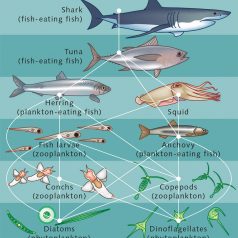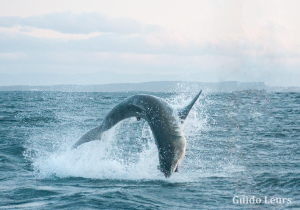
Often when I talk to people about sharks, almost immediately they ask about the apex predators that they have seen in documentaries or in videos circling on social media. The white shark that breaches out of the water and grabs a sea lion from the water surface, a tiger shark that feeds on young albatrosses as they rest on the water surface before their first flight, or tiger sharks attacking green sea turtles after they come back in the sea from their nesting beach. These are all stories straight from the spectacular documentaries (don’t get me wrong, I love them just as much as you do. Or more.), but how high are sharks in the marine food web? The last couple of years, science has been adjusting the answer to this question little by little based on new research.
Currently, science describes 1.149 species of elasmobranchs, that is 516 shark species and 633 ray species [1]. Only a few of these receive their moment of fame in nature documentaries; white sharks, tiger sharks, bull sharks, whale sharks, hammerheads, and a variety of reef shark species. The documentaries often illustrate that sharks are apex predators (at the apex/top of the food chain), whereas really, these sharks are also opportunistic scavengers [2,3]. They are even preyed upon by the orca [4]. Now, this doesn’t necessarily mean that the orca has a higher position in the food web, it could also mean that the orca preys on large sharks to get rid of unwanted competition for a common food source.

Out of the 500 shark species, most have a relatively small body size. Species like the bullhead shark, catsharks and a variety of ray species are therefore likely to fall prey to larger predators. This is also reflected by the (large variety) of defense mechanisms that these smaller species possess, like a barb at the base of the tail of stingrays, or the spine in front of the dorsal fin of dogfish and bullhead sharks. And then there are the shysharks (a family of catsharks), which curl up their body into a circle in a threatening situation to look bigger for potential predators. The fact that these sharks are adapted to prey on shellfish, crustaceans, and small bony fish, but at the same time possess these defense mechanisms, indicates that these species are not located at the top of the marine food chain. Recent research confirms that rays and small shark species are positioned lower in the marine food chain compared to bigger, more mobile shark species [5].
Threats to small shark and ray species often come from other, larger, shark species. The diet of the great hammerhead is made up of a large portion (up to 82%) by other elasmobranchs [6]. Some shark species, such as lemon sharks, are known to be cannibalistic, causing juvenile lemon sharks to be at risk of older lemon sharks [7]. That is probably the main reason why juvenile sharks tend to grow up in habitats sheltered from adults of the same species [7]. The position of sharks within the marine food web also changes over their lifetime [5,8]. For example, juvenile white sharks feed primarily on bony fish, whereas adults supplement their diet by feeding on marine mammals like sea lions [8].
The Caribbean reef shark and nurse shark, two of the most predominant species on the Dutch Caribbean islands, are among the largest predators in their ecosystem, and as such, seem to play a vital role in the marine food web.
Due to the high diversity of species, and the large variety in habitat use and body size, sharks take up a large variety of trophic positions in the marine food web. The exact consequences of shark removal of a marine ecosystem, therefore, remains subject to discussion among scientists [9,10,11]. However, it is clear that only a few species actually reside at the top of the food chain, while the rest of the species has to keep their senses ready for the looming threat of potential predators.
Video tips:
– Orcas eating seven gill shark
– Sea lion eating and defending leopard shark
– Whitetip reef shark eaten by murray eel, but escapes
-
- Last, P. R., White, W. T., de Carvalho, M. R., Séret, B., Stehmann, M. F. W., & Naylor, G. J. P. (Eds.). (2016). Rays of the World (First Edition). New York: Cornell University Press.
- Long, D., & Jones, R. (1996). White Shark predation and scavenging on cetaceans in the Eastern North Pacific Ocean. In Great White Sharks: The Biology of Carcharodon carcharias (pp. 293–307). Academic Press.
- Heithaus, M. (2001). The biology of tiger sharks, Galeocerdo cuvier, in Shark Bay, Western Australia: sex ratio, size distribution, diet, and seasonal changes in catch rates. Environmental Biology of Fishes, 2, 25–36.
- Pyle, P., Schramm, M. J., Keiper, C., & Anderson, S. D. (1999). Predation on a White Shark by a Killer Whale and Possible Case of Competative Displacement. Marine Mammal Science, 15(2), 563–568.
- Navia, A. F., Mejía-Falla, P. A., López-García, J., Giraldo, A., & Cruz-Escalona, V. H. (2016). How many trophic roles can elasmobranchs play in a marine tropical network? Marine and Freshwater Research, 1–12.
- Cliff, G. (1995). Sharks caught in the protective gill nets off KwaZulu-Natal, South Africa. 8. The Great hammerhead shark Sphyrna mokarran (Rüppell). South African Journal of Marine Science, 15(1), 105–114.
- Guttridge, T. L., Gruber, S. H., Franks, B. R., Kessel, S. T., Gledhill, K. S., Uphill, J., Sims, D. W. (2012). Deep danger: Intra-specific predation risk influences habitat use and aggregation formation of juvenile lemon sharks Negaprion brevirostris. Marine Ecology Progress Series, 445, 279–291.
- Hussey, N. E., Mccann, H. M., Cliff, G., Dudley, S. F. J., Wintner, S. P., & Fisk, A. T. (2012). Size-based analysis of diet and trophic position of the white shark (Carcharodon carcharias ) in South African Waters. In M. L. Domeier (Ed.), Global Perspectives on the Biology and Life History of the White Shark (pp. 27–49). CRC Press.
- Roff, G., Doropoulos, C., Rogers, A., Bozec, Y. M., Krueck, N. C., Aurellado, E., Mumby, P. J. (2016). The Ecological Role of Sharks on Coral Reefs. Trends in Ecology and Evolution, 31(5), 395–407.
- Ruppert, J. L. W., Fortin, M.-J., & Meekan, M. G. (2016). The Ecological Role of Sharks on Coral Reefs: Response to Roff et al. Trends in Ecology and Evolution, 31(5), 395–407.
- Grubbs, R. D., Carlson, J. K., Romine, J. G., Curtis, T. H., McElroy, W. D., McCandless, C. T., Musick, J. A. (2016). Critical assessment and ramifications of a purported marine trophic cascade. Scientific Reports, 6(February), 20970.
By Guido Leurs





